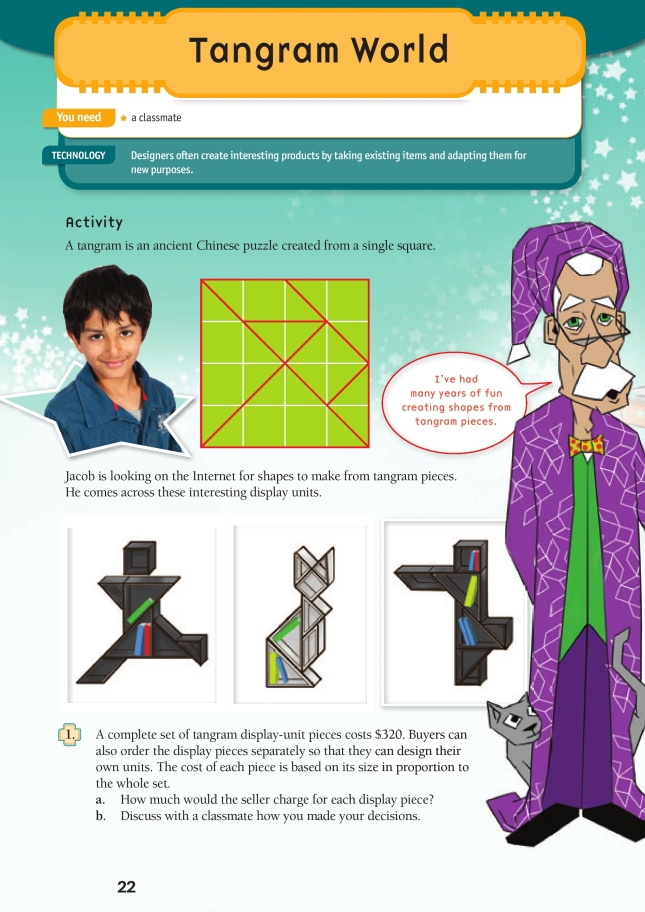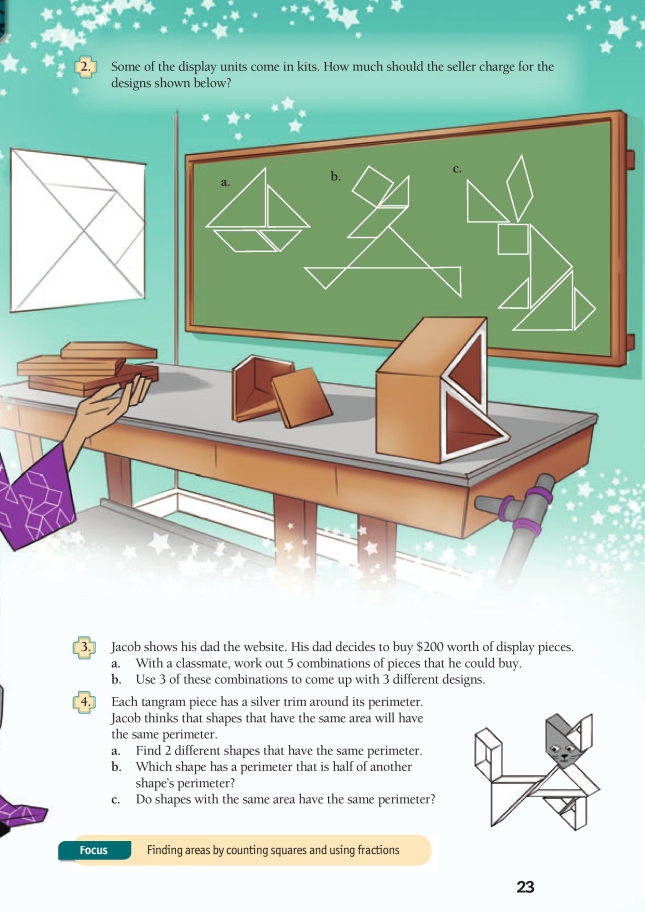This is a level 3 activity from the Figure It Out series.
A PDF of the student activity is included.
Click on the image to enlarge it. Click again to close. Download PDF (498 KB)
Comparing the size of different shapes requires a shared unit. In this activity, students are presented with seven tangram pieces and asked to decide how much each piece should cost. This involves finding out what fraction of the tangram square each piece is. Students then explore whether there is a relationship between area and perimeter (the distance around the outside of a shape).
FIO, Technology Rules!, Levels 2+-3+, Tangram World, pages 22 - 23
In this activity, students explore the area and perimeter of the shapes in a tangram square. Make sure that students are familiar with the name of each shape: triangle, square, and parallelogram. A very good website for the history of tangrams, tangram puzzles, and online activities is www.tangrams.ca
Activity One can be solved using fractions. Note that the tangram square can be divided into several different units. For example, the largest triangle makes up one-quarter of the tangram square. If the cost of each piece is based on its area, the large triangle should be one-quarter of $320. $320 ÷ 4 = $80. A common convention when describing area is to use square units. However, the tangram square could also be divided into small triangles (64 half squares), or the smallest tangram shape could be used as a unit (2 small triangles).
Students who fi nd Activity One challenging can be given a paper copy of the tangram square. Cutting up and rearranging the parallelogram will show that the parallelogram has an area equivalent to 2 of the 16 squares that make up the tangram square.
While the class is working, circulate to identify the strategies that students are using. Ask specific students to share their strategies with the class.
Discuss the concept of equivalence with the class. For example, 4/16 is equivalent to 1/4 and 2/16 is equivalent 1/8.
In question 4, the students explore the relationship between the perimeter and the area of a shape.
The students do not need to use measurement to compare the perimeters of the tangram shapes. All of the shapes have sides that are made up of diagonal or horizontal and/or vertical units within the tangram square, as shown in the table below (and in the diagram under Extension).
| Shape | Horizontal/vertical units | Diagonal units |
| Triangle 1 | 2 | 2 |
| Triangle 2 | 4 | 2 |
| Triangle 3 | 4 | 4 |
| Square | 0 | 4 |
| Parallelogram | 4 | 2 |
Note that the perimeter of the largest triangle is only twice the perimeter of the smallest triangle, even though its area is 4 times larger.
Intuitively, it makes sense that some connection exists between area and perimeter: a large shape should have a large perimeter; a small shape should have a small perimeter. In the tangram square, the two shapes with the same perimeter have the same area. However, exploring different shapes reveals that two shapes with the same area can have different perimeters. Things are not as straightforward as they seem!
Extension
Ask students to solve the following puzzle:
The cost of the silver trim used on the shelves is shown in the table. The cost is based on the number of vertical or horizontal units and the number of diagonal units that make up the perimeter of each shape. Use the table below to work out which shape corresponds to each letter, then the cost per vertical or horizontal edge unit and the cost per diagonal unit.
The problem can be solved by identifying which shapes match each letter. For example, the smallest triangle has a perimeter that is half that of the largest triangle, so they are shapes A and E respectively. The parallelogram and the middle triangle have the same perimeter, so they must be C and D. The square (B) is made up of 4 diagonals, so the cost of a diagonal unit is $12 ÷ 4 = $3. This information can be used to find the cost of a vertical or horizontal edge using a different shape. For example, the smallest triangle costs $10 and has 2 diagonals and 2 vertical or horizontal sides. $10 – 2 x 3 = $4 for the remaining 2 sides, so they must be $2 each.
Making connections develops the key competency thinking (in this case, both lateral and logical).
Technology-related student activities
- Use tangrams to construct an image for a birthday card.
- Investigate logos and design their own to brand a school production, gala, or sports team.
- Identify or describe the component parts of items such as a bicycle wheel, a piano, or a torch.
A useful website is: www.tangrammit.com
An Internet search for images of logos from tangrams will bring up a huge range for the students to explore.
Exploring the technology-related context
Designers can often create original products by adapting existing products for new purposes or by constructing an item from a number of smaller items, each playing its own part. The tangram shelves are a good example of this.
Using the tangram pieces, students will be able to construct representations of familiar figures. From various types of polygons, new shapes will emerge. These representations will be in stylised form, where the object represented is recognisable but is not realistic. Designers often use these stylised forms to produce logos, which help establish a brand through an instantly recognisable image.
Answers
Activity One
1. a. One way to approach this problem is to find the area of each shape in terms of small squares. The tangram square is made up of 16 smaller squares. Each small square should be worth $20 each (320 ÷ 16 = 20). Therefore the costs are as follows: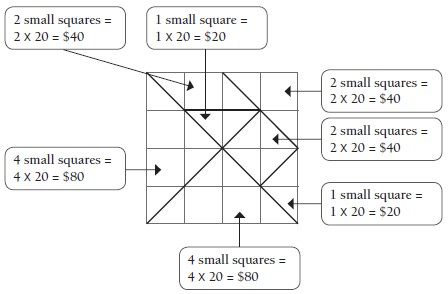
An alternative approach is to use fractions. For example, the largest triangles each take up one-quarter of the tangram square, so they should be one-quarter of the price. $320 ÷ 4 = $80.
b. Discussion will vary.
2.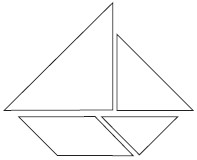
Boat: 80 + 40 + 40 + 20 = $180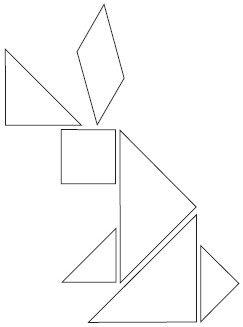
Rabbit: 40 + 40 + 40 + 20 + 80 + 80 + 20 = $320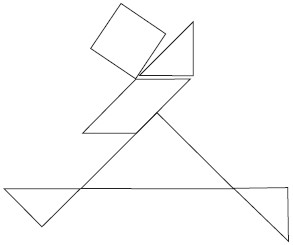
Running man: 40 + 20 + 40 + 80 + 20 + 20 = $220
3. a. Combinations will vary, but they must add up to no more than $200.
b. Designs and pieces will vary.
4. a. The parallelogram and the middle-sized triangle have the same perimeter.
b. The perimeter of the smallest triangle is half the perimeter of the largest triangle.
c. As a rule, shapes with the same area don’t have the same perimeter. For example, the parallelogram, the middle-sized triangle, and the square all have an area of 2 small squares. However, the perimeter of the square is four “diagonal” units, whereas the other two shapes have a larger perimeter of four “horizontal or vertical” units and two diagonal units.
